Dukes County’s quaint, picturesque, Georgian-Colonial red brick and white trimmed courthouse was the focus of much of the world’s attention this week, and the adjectives in the first part of this sentence are a fair sampling of the ones dredged up by the reporters straining to give their prose a desperately needed dash of color.
The reporting job done on the courthouse, actually a building uneasily attempting to hide its Victorian origins behind some latterday embellishments of classical pretension, underlined the many problems of trying to cover a closed inquest. With the real news of the occasion transpiring in secrecy, the world’s press had to fall back on other subjects more or less tangential to the main event.
Photographers, living by the principle established by the old adage about the ratio of advantage between one picture and a thousand words, had a somewhat easier time of it, but even they were hardpressed to come up with a variety of aspects of the event. John N. Farrar was photographed once holding a rifle, and another time holding a fishing rod. Mrs. William C. Parks was photographed holding a cup of coffee in the Methodist Church kitchen. Chief Dominick J. Arena of the Edgartown police was photographed holding a flashlight looking for “bugs” in the courtroom.
Job of Making News
So went the job of making news. Judge James A. Boyle’s avocation as a golfer was given full play in the papers. It was duly recorded for the world to read that Dick Hewitt was still calmly piloting the Chappaquiddick ferry back and forth across the harbor. Russell Peachey, the co-owner of the Shiretown Inn, arrived in Edgartown Monday, in time to read the splashy and astonishing headline in the Boston Record-American that he was misisng.
Once again, as it was in July and in September, the news in Edgartown was the process of news making itself, only this time there were fewer matters to distract from its dominance. Reporters with notepads and pencils poised and photographers with their cameras cocked running along after witnesses at the inquest were more visible this time on a less crowded Main street.
The newsmen gathered on the scene early Monday morning in the crackly cold for the long wait until 10 o’clock when the inquest was begun, a motley crew if ever there was one, in their assortment of winter raiment.
Some of the television people looked like a group of aging boys prepared to go sledding in light of blue windbreakers and stocking caps with pompoms. Once male photographer cut a dashing figure in a midi-length black fur coat and a matching fur hat, his tripod flashing in the sunlight very much like a silver walking stick. Jane Brumley, who covers politics for Newsweek, was there in a maxicoat of uncompromising fire-engine red. The columnist, Mary McGrory, stood swathed to the nose in a scarf, in a kind of New England yashmak. John Fenton, appropriate to a gentleman from the Times, wore earmuffs of a conservative navy blue.
Vantage Point for Photographer
In contrast, there was a young photographer who stood perched on one of the leftover Main street Christmas tree stands, facing the wind with only a light corduroy jacket to ward off the cold.
Long before Senator Kennedy, hatless and in an open overcoat, and his wife, her long blond hair tossing gently in the wind, made their brisk walk down School street from the former Larkin house leased by the Kennedy lawyers as their headquarters, the mass of reporters, photographers and cameramen had become a joggling band of red-faced foot-stompers and hand-rubbers, and as time went on and the chill became ingrained in the marrows of journalistic bones, there were probably dreams of the hot coffee over in the Methodist Church dancing in their heads.
At the church, there was a continual shifting of reporting personnel and a constant buzz of conversation. The blue haze of smoke from cigarettes, cigars and pipes gave notice that at least this part of the old building had been temporarily de-sanctified. Mingled with the smoke was the aroma of hot coffee, coming from the kitchen window, where the women of the church did a brisk business dispensing sandwiches, cupcakes and stew, and listening to quips about paying off the church mortgage.
A Party Given by Mrs. Trask
If the church women could be described as angels of mercy, some more elegant term should be ascribed to Mrs. John J. Trask, who undertook to give succor to the homeless on another scale Monday night. She posted a notice on the bulletin board at the communications center that all the newsmen and telephone personnel were invited to a party at her home on the corner of School street and Davis Lane that evening.
Apparently nearly everyone took her up on her offer, The house was packed with celebrants, and the measure of success of the evening can be taken by the fact that the bartender was kept on duty two and a half hours after the prescribed limit.
The inquest had its unsung heroes, of course, and among them were the communications center’s guards, whose main job it was to keep curiosity-seekers out. In the daytime, the guard was Cornelius Silva, off-duty from his regular highway department functions. In the evenings, it was Ellsworth Fisher, the retired telephone operator. And on the graveyard shift, it was Miss Carmen Salvador, the police woman, accompanied by her German shepherd, Crewser.
An Amazing Resemblance
On Wednesday, the promised blizzard arrived, but in the form of a comparatively gentle snowstorm. With it came a renewed jocularity among the newsmen and officers standing in front of the courthouse that morning waiting for witnesses to arrive. Some threw snowballs at each other. With the snow, too, there came an Italian movie actor bearing a noticeable resemblance to the late Senator Robert F. Kennedy and, of course, his agent.
Many of the city reporters appeared to take this overt bid for publicity almost as if something like it were sooner or later expected, and, there being little else to write about, dutifully interviewed the pair. Others found the appearance of the actor in these circumstances lacking in good taste, especially since he still stood there smiling on the courthouse steps when three of the young women who had been workers in Robert Kennedy’s campaign for the Presidential nomination arrived for the day’s proceeding.
And the Leak
Another more unsettling occurrence was the leak somehow wangled by Philip Balboni of UPI, which enabled him to write that Senator Edward M. Kennedy had testified at the inquest that he had had nothing to drink at the party on Chappaquiddick, from which he and Miss Kopechne had left to go to the ferry, but met with tragedy instead.
The leak was the source of some chagrin to the other newsmen trying to file daily stories based on little else than the goings and comings of witnesses through the courthouse doors.
The leak was perhaps inevitable, and an observer could not help but wonder if a part of the chagrin of the other reporters was not based on envy of Mr. Balboni and his good luck to have something solid to write about for once. Still and all, it made something of a mockery of the decision of the state Supreme Judicial Court regarding the necessity for the inquest to be conducted in absolute secrecy.




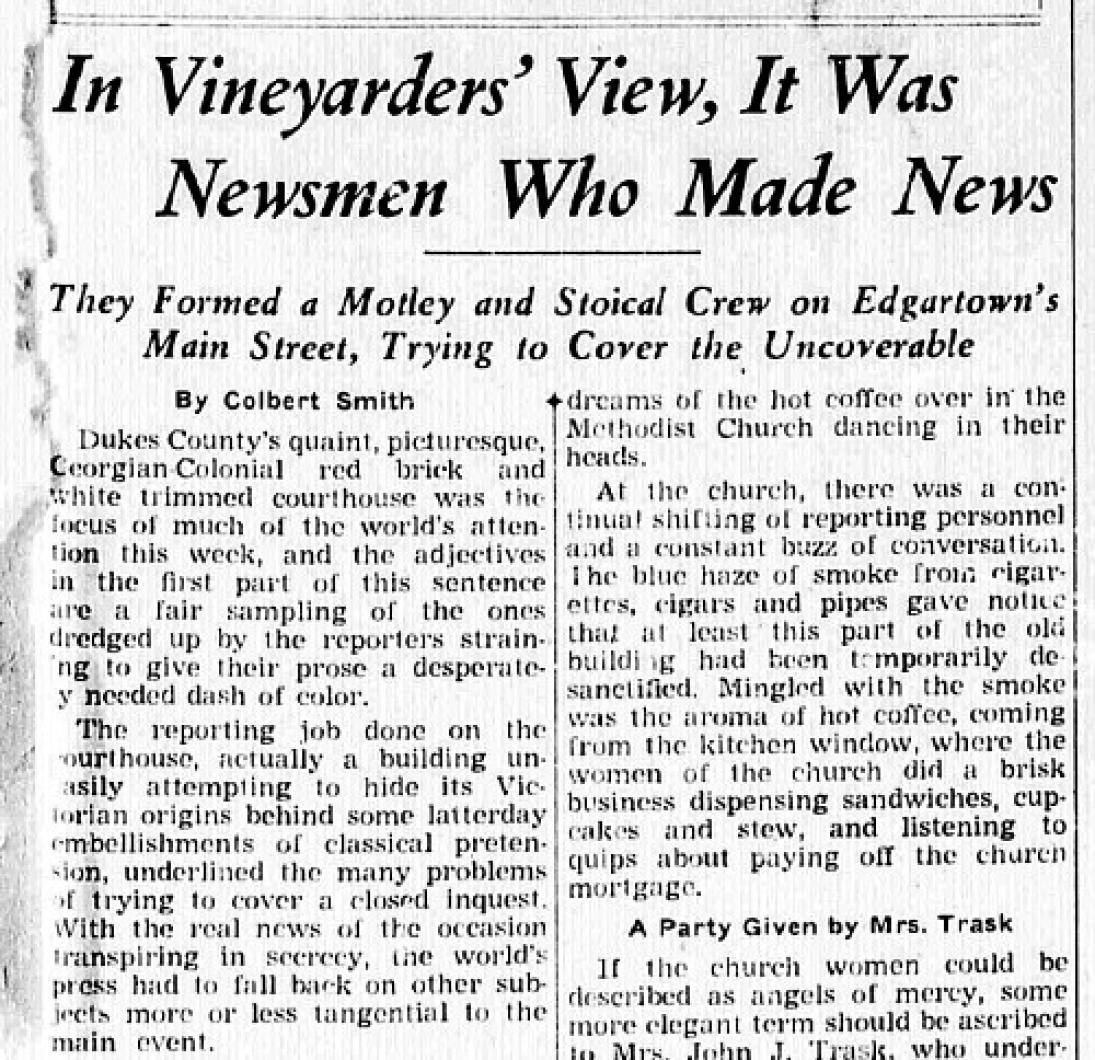
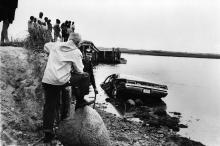
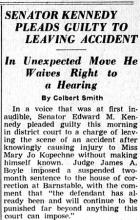
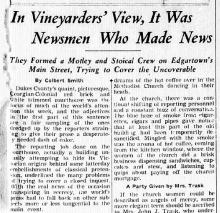
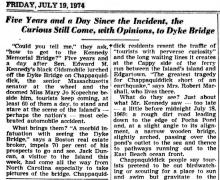
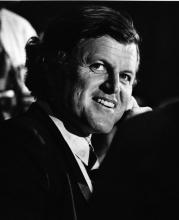
Comments